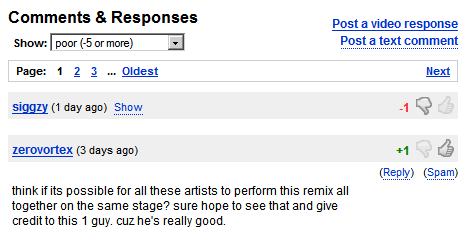
It was obvious for everyone that Google payed $1.65 billion for YouTube to gain access to a great platform for testing and distributing video ads. The problem is that many YouTube users hate ads and if they had to watch a 15 second commercial before every video, they'd leave YouTube for another video site.
Google's solution, very similar to VideoEgg's ticker ads, is to overlay a small ad at the bottom of a video for about 10 seconds. If you click on the ad, a new video will open in the same player and show you more information about the offer. Once the video ad ends, you can continue to watch your video. The beauty is you can simply ignore the ad, although it takes some time to get used to the small animation.
A comment from YouTube's blog brings an interesting point:
I have a problem with the in video ads for one reason, and that is that they would disrupt and obstruct content. As an artist who sometimes works with digital video, I realize that the choices made in framing a shot are very important. Everything in the frame at any given moment during a video is important to that video's composition and appeal. For this reason I feel that InVideo ads would be a disruptive and negative addition to the Youtube experience. I would suggest instead that adds could be placed at the end of the video, instead of the rolling related video reels.
The ads are still an experiment and won't be added to user-generated videos.
"For now, Google will place the ads only on video clips of its content partners — the more than 1,000 small and large media companies that have licensed their videos to YouTube. By doing so, YouTube will avoid the potential liability of having ads appear on copyrighted clips it is not authorized to display. And it will also prevent ads from playing on clips generated by users whose message may not be to the liking of advertisers. The revenue from the ads will be split between the media partner and YouTube. Ms. Naughton said Google would charge advertisers $20 for every 1,000 times the ads were displayed. Google said the ads would begin appearing today throughout the site. Ms. Naughton also said advertisers would be able to take aim at specific channels and genres, as well as demographic profiles, geography and hour of the day," reports The New York Times.
You might be able to spot the overlay ads in this video. Here's a short demo from Reuters:
The ads were also spotted last month:
YouTube also added new community features: now you can display on your profile page the latest videos you've rated and the comments have a Digg flavor: you can rate them and see only the top-rated comments.

Videos are like books. You have to pull the reader in and make them curious and interested within the first couple paragraphs. Likewise, successful videos begin not just because boh3m3 says something funny, but he makes a weird hand gesture or facial expression, which might be missed if an ad blocks the view. The point is, if Google wants the ad to be viewed instead of the video, then this is no longer a video service, but an ad service. Even just 10 seconds long, it still attempts to steal the viewer's attention from what they want. I wouldn't call that unobtrusive--this is worse than a Yahoo! ad.
ReplyDeleteA better alternative, in my opinion, would be to use what Google does best: figure out what a video talks about (if they mention duct taping someone to the ceiling) and then put a link at the end of the video or on the side of the page (so that users can buy some duct tape online so they, too, can duct tape their best friend to a chair, as they watched in the video). This makes a lot more sense. If someone is blending a yummy dessert, then have links to safeway.com and blender companies. This would actually be useful, and I might actually be willing to click on one of those ads.
jyvyn makes a good point there!
ReplyDeleteYou can use TubeStop (http://www.chrisfinke.com/addons/tubestop/) to stop the ads and autoplay. The website says,
ReplyDeleteTubeStop is an extension for Mozilla-based Web browsers that disables the autoplay on YouTube videos. This means that you can open multiple YouTube videos in tabs in the background without them all starting to play at once. TubeStop also disables the autoplay on YouTube videos embedded on non-YouTube.com sites (MySpace, for example).
It works by replacing the standard YouTube player with the embedded player, which doesn't have autoplay or ads (yet).
Another vidoe-website that has promoting video classifieds is www.iPoste.org.
ReplyDeleteiPoste.org is dedicated to connecting like minded people , through words,
pictures and audio/video content.
By logging on to iPoste org you can be instantly connected to your local interest community where you can find the most recent classifieds,
the latest news and events postings, video and text forums from people who share the same interest..... and a directory with all the businesses, organizations and people who
serve your community.
With our new video features you can also upload your own self produced videos.
So, wether you own a small business and want to make your own web commercial, are an individual who wants to make and broadcast your own video classified,
or an artist who wants to highlight their latest work in video, iPoste.org is the perfect place to upload your self produced
video content and show it to the people that are the most interested... and to the world..